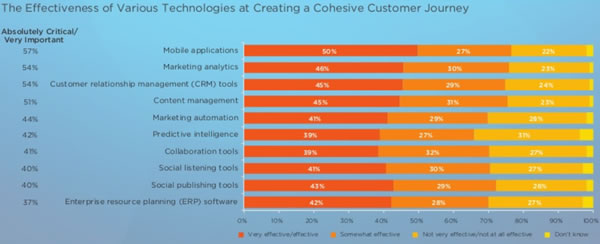The essential role of customer experience – and the increasing focus on the customer journey – is driving many evolutions in the corporate world and within organizations. Digital marketing transformation is one of them.
Digital transformation processes, for instance, nowadays are predominantly led by customer (experience) goals. We see that digital marketing transformation (not to be confused with digital transformation as such as is too often the case) ranks high on the agenda of many organizations striving towards a more customer-centric view around experiences and the overall customer journey and life cycle. In this article we take a closer look at digital marketing transformation.
The transformational role of customer experience in marketing and beyond
Before doing so, here are some other areas where the customer experience has a transformational impact. And in today’s connected and digital world, they are all closely and increasingly related with digital marketing from the customer experience viewpoint. After all, transformation is a lot about integration around the customer in the broadest sense.
- The transformations within call centers and customer service departments of organizations: led by increasing customer expectations and the increase of channels and data (and changing customer interaction preferences). The whole discussion about moving the call center to an omni-channel contact center in which there needs to be a clearer role of the contact center in creating customer value instead of being perceived as a cost center is a lot about customer experience optimization (and cost efficiency).
- The evolution of the IT function: experiences and outcomes first whereby the traditional approach to IT is changing. User and customer adoption, shaped by experiences, are more crucial than ever and the whole shift towards user/customers even leads to a bimodal view on IT (or, as some – in our view more accurately say – a tri-modal approach).
- Shifts in the roles and even new roles within the C-suite: the digital customer leads the dance here as well. Also think about the creation of new functions such as the Chief Customer officer, which started a few years ago and, increasingly, the discussions about using customer experience and customer satisfaction metrics as performance metrics to gauge the performance of C-level execs and their teams. Finally, there is a big debate about who is responsible for the results (not the same thing as the ownership) of anything that’s related to the customer experience and even the digital customer experience.
Digital marketing transformation and customer experience – intent
Even if marketing is far from the only department involved in customer experience, investments seem to be driven by an increasing focus on that customer experience and the customer journey.
Sign of the times in that regard: according to the 2015 State of Marketing Report from Salesforce, marketers are increasingly entering what was relatively unknown domain for them: the customer experience as such but also customer journey mapping, etc.
I quote from the report, which you can download here or watch in a SlideShare version below: “increasingly, marketers are shifting attention from traditional metrics like conversion rates and return on investment to metrics that better reflect customer satisfaction”.

Customer satisfaction and customer experience go hand in hand. I would even add that conversion and return on investment also go hand in hand. In fact; every single conversion optimization expert I know, regardless of tactics and channels, is a customer experience or customer-centric champion, understanding journeys, to begin with.
None of them ever put the “technical” aspects of conversion optimization (such as testing tools, personalization, search engine tweaks or dynamic content) before the human experience, journey and frictionless flow perspective.
The Salesforce report (based on a survey of 5,000 marketers) states that the customer now rules (let’s hope), and speed is the new currency of business, with an increasing number of marketers looking at an entire marketing strategy “under the umbrella of a cohesive customer journey, which we define as all of the interactions a customer has with brands, products, or services across all touchpoints and channels”. The customer experience and customer journey as the leitmotiv and glue of integrated and connected – digital – marketing indeed.
Salesforce refers to other research, The State of Marketing Leadership, conducted by Salesforce and LinkedIn, and published end 2014. 86% of senior-level marketers in that research say that ” it’s absolutely critical or very important to create a cohesive customer journey.”
Time to move from intent to action
In all fairness, it has taken marketers far too long to understand this and they have no other option as today’s – digital customer – will clearly let you know (not just voicing his opinion but mainly voting with his wallet) if he doesn’t find the consistent and cohesive connected experience he clearly wants.
Also: in practice there is still a lot of work to do.
- First of all, there’s a big difference between what senior-level marketers say and what happens in practice.
- Second of all, marketing is just one piece of the overall customer experience and customer journey equation.
And let’s be honest: these kinds of messages have been heard before. Still, it seems there finally is a shift going on. The Salesforce research is far from the only showing it.
In its CMO Spend 2015 research, Gartner states that digital marketing spend is “entering new territories” with “a customer-centric, integrated marketing mix drawing funds from unique sources”. The first key takeaway: customer experience has marketers’ full attention. And it’s about time. Even more interesting: the focus on customer experience is blurring organizational lines.
Let’s hope it’s more than hype this time as I sometimes fear when seeing how often the basics are still overlooked – or, even worse, just paying lip service while remaning stuck in silos.

